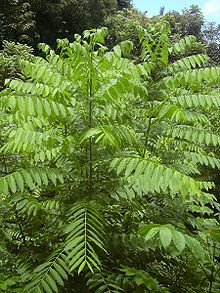Cedrela
| Cedrela | |
|---|---|

| |
| Cedrela odorata foliage | |
| Scientific classification | |
| Kingdom: | Plantae |
| Clade: | Tracheophytes |
| Clade: | Angiosperms |
| Clade: | Eudicots |
| Clade: | Rosids |
| Order: | Sapindales |
| Family: | Meliaceae |
| Subfamily: | Cedreloideae |
| Genus: | Cedrela P.Browne |
| Type species | |
| Cedrela odorata | |
| Species | |
|
See text | |
Cedrela is a genus of several species in the mahogany family, Meliaceae.[1] They are evergreen or dry-season deciduous trees with pinnate leaves, native to the tropical and subtropical New World, from southern Mexico south to northern Argentina.[2][3]
Taxonomy[]
These species are currently accepted:[1][3]
- Cedrela angustifolia Sessé & Moc. ex C.DC. – Argentina, Bolivia, Brazil, Ecuador, Peru
- S.F. Blake
- S.Watson
- Cedrela fissilis Vell. – Costa Rica south to Argentina
- T.D. Penn. & Daza
- Harms
- T.D. Penn. & Reynel
- T.D. Penn.
- Cedrela montana Moritz ex Turcz – Colombia & Ecuador
- T.D. Penn. & Daza
- Cedrela odorata L. – West Indies and from 24° N in Mexico south to 28° S in Argentina
- C.DC. & Rose
- M.A. Zapater & del Castillo
- Standl. – Central America
- Cedrela tonduzii C.DC. – Central America
- Harms
Distribution and habitat[]
Cedrela odorata is the most common species in the genus, widespread in seasonally dry tropical and subtropical forests; it is deciduous in the dry season which may last several months. C. angustifolia and C. montana occur at higher altitudes in moister conditions, and are evergreen or only briefly deciduous.

Uses[]
Cedrela odorata is a very important timber tree, producing a lightweight fragrant wood with very good resistance to termites and other wood-boring insects, and also rot-resistant outdoors. The wood is often sold under the name "Spanish-cedar" (like many trade names, confusing as it is neither Spanish nor a cedar), and is the traditional wood used for making cigar boxes, as well as being used for general outdoor and construction work, paneling and veneer wood. It is also used for the necks and linings (interior strips of wood that attach the top and bottom of the guitar to the sides) of classical guitars, as well as bodies and necks of some electric guitars. Some species are now CITES-listed, in particular Cedrela odorata.[4] It is also grown as an ornamental tree, and has become naturalized in some areas in Africa, southeast Asia and Hawaii. The other species have similar wood, but are less-used due to scarcity.
References[]
- ^ a b Pennington, T. D. (1981). Meliaceae. Flora Neotropica. New York Botanical Garden. ISBN 9780893272357.
- ^ "Neotropical Meliaceae - Neotropikey from Kew". www.kew.org. Retrieved 2016-01-25.
- ^ a b Pennington, T. D.; Muellner, Alexandra N. (2010). A Monograph of Cedrela (Meliaceae). dh books. ISBN 9780953813476.
- ^ "CITES species database entry for Cedrela odorata". Retrieved 2012-10-22.[permanent dead link]
External links[]
- Cedrela
- Meliaceae genera